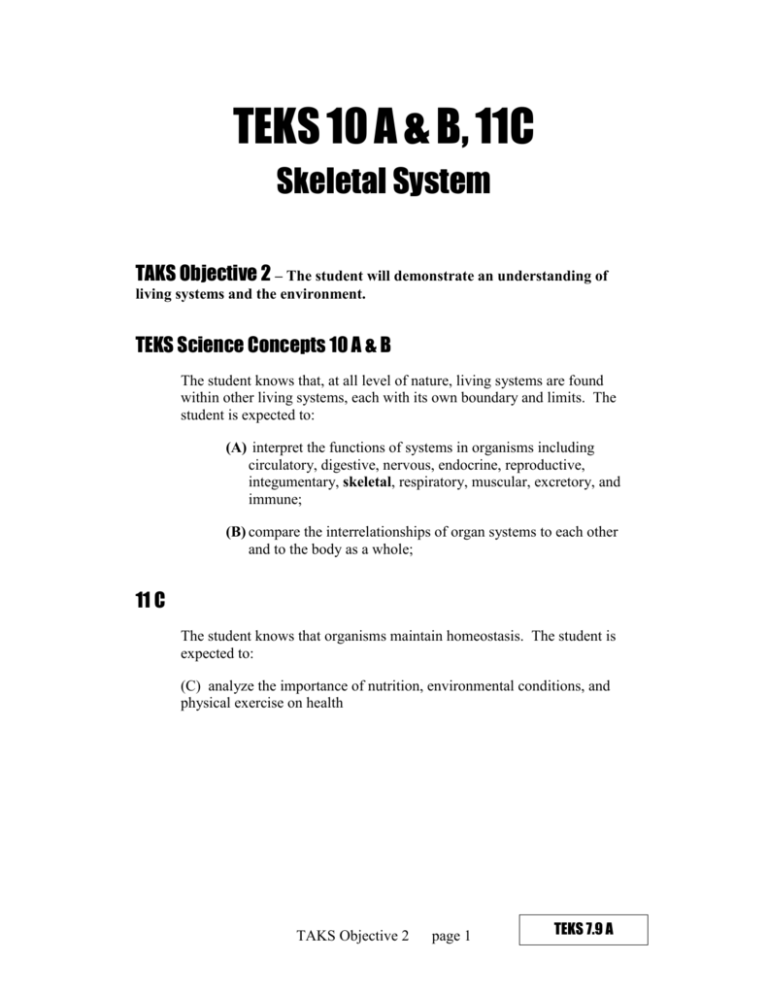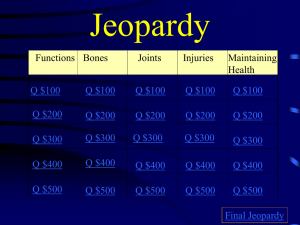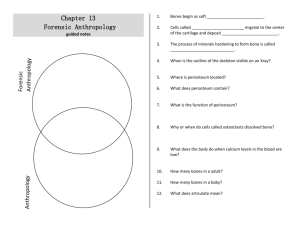Skeletal System {Word Document}
advertisement

TEKS 10 A & B, 11C Skeletal System TAKS Objective 2 – The student will demonstrate an understanding of living systems and the environment. TEKS Science Concepts 10 A & B The student knows that, at all level of nature, living systems are found within other living systems, each with its own boundary and limits. The student is expected to: (A) interpret the functions of systems in organisms including circulatory, digestive, nervous, endocrine, reproductive, integumentary, skeletal, respiratory, muscular, excretory, and immune; (B) compare the interrelationships of organ systems to each other and to the body as a whole; 11 C The student knows that organisms maintain homeostasis. The student is expected to: (C) analyze the importance of nutrition, environmental conditions, and physical exercise on health TAKS Objective 2 page 1 TEKS 7.9 A For Teacher’s Eyes Only Teacher Background: There are twelve major organ systems in the human body (i.e., circulatory, skeletal, respiratory, excretory, integumentary, nervous, digestive, endocrine, reproductive, immune, lymphatic, and muscular systems). In this TEKS, we will introduce students to the common structures of each system and their basic functions. A brief description of these systems follows: Skeletal System – The skeletal system has five major functions in the body, provide structure and support for the body, protect internal organs, attachment for muscles for movement, make blood cells, and store mineral. There are approximately 206 bones in the mature adult body. These bones are categorized into two different skeletons, the axial skeleton consisting of the skull, vertebral column and rib cage and the appendicular skeleton, which includes all of the bones of the appendages. Bones of these two skeletons are further subcategorized into long bones (femur), short bones (ankle and wrist bones), flat bones (sternum), irregular bones (facial bones), sesmoid bones (patella) and sutural bones (located in sutural joints between cranial bones) vary greatly in number from person to person. All bones consist of two main types of bone tissue, compact and spongy tissue. These two types of tissue are what provide the strength, mineral storage ability and blood producing ability of bones. Compact tissue forms the very hard outer shell of the bone, whereas the spongy (cancellous) bone is a meshwork of bones called trabeculae that contains bone marrow. Student Prior Knowledge Students should be familiar with the components associated with body systems TEKS 6.10 (C) identify how structure complements function at different levels of organization including organs, organ systems, organisms, and populations and the functions of these systems. TAKS Objective 2 page 2 TEKS 7.9 A No Bones About It! 5 E’s ENGAGE Osteoporosis Questionnaire (Blackline Masters) Teacher Demo-Deboned What would happen if humans did not have bones? Your body would be limp like a rag doll. Could you stand up? No way. Could you walk? Forget about it. Without bones in your body, you would be like the blob. Use the “Deboned” activity in the blackline masters. Place the table on the board, overhead or projector and as a class, have students compare and contrast chicken legs soaked in vinegar and those that were not soaked in vinegar. Observations should include things such as the bones soaked in vinegar were weaker and more flexible. Teacher explanation should include talk about mineral stores in bones and that vinegar (acid) dissolves calcium phosphate in bones causing them to become weak. Hence the importance of balanced diet with calcium to maintain strong bones. EXPLORE Exploration 1 The Calcium Test Students will test various types of materials to determine the presence or absence of calcium. TAKS Objective 2 page 3 TEKS 7.9 A Exploration 2 Computer Lab http://www.medtropolis.com/VBody.asp Students will visit the above website and answer the following questions while navigating through the narrated skeletal system section: (In blackline masters) 1. List the 5 main functions of our skeletal system. 2. What are two things that our skeletal system stores? 3. What type of bone cells break down bone? What type of event would cause them to break down bone? 4. What type of bone cells form bone tissue? What event causes them to form more bone tissue? 5. How many bones does the average mature adult have in their body? 6. What are three things that our bones need to stay healthy? 7. List 5 different bones that are found in our body. EXPLAIN Complete the Skeletal System Power Point Presentation with question and discussion of the following type of information: 1. Bones have five main functions: 1. provide structure and support for body 2. protect internal organs 3. make blood cells 4. store minerals 5. attachment for muscles for movement TAKS Objective 2 page 4 TEKS 7.9 A ELABORATE Elaboration1 How Much Calcium Do I Eat? Students will calculate their most recent calcium intake to determine their dietary calcium needs and how to reduce their risk of osteoporosis. EVALUATE 1. After observing the chicken bone soaked in vinegar and water and participating in a class discussion, the learner will produce a Venn diagram, table or sketch in his/her journal to compare and contrast the bones. A grade of pass/fail will be given. 2. Using the text, and class notes, the learner will produce a labeled sketch in his/her journal that describes the components of a bone. A grade of pass/fail will be given. 3. Using the text, information from the website, and class notes, the learner will demonstrate an understanding of the structures and list at least 4 functions of the skeletal system by creating labeled drawings and providing a 100-word summary of the overall function of the skeletal system. A minimum score of 70% on the rubric is required. 4. After completing the Q-tip skeleton, the learner will identify the following major bones of the body: skull, spine, ribs, pelvis, femur, tibia, fibula, humerus, radius, ulna, phalanges, and clavicle. TAKS Objective 2 page 5 TEKS 7.9 A TAKS Objective 2 page 6 TEKS 7.9 A Obtained from http://www.girlscouts-rh.org/docs/bbones-ipa-book.pdf TAKS Objective 2 page 7 TEKS 7.9 A Deboned 1. Observing the bones soaked in acid and the bones soaked in water, list as many similarities and differences that you can you can detect with your senses. 2. After compiling your list and participating in class discussion, produce a Venn diagram or labeled sketch to demonstrate the similarities and differences between the bones. Similarities TAKS Objective 2 Differences page 8 TEKS 7.9 A The Calcium Test Overview: One job of the skeleton is to support the body. Bones are specially suited for this job because they are made of strong material. Bones are made of calcium. In nature, limestone contains calcium, and many animals use calcium’s rocklike strength to construct their shells. Seashells, for example, are constructed with calcium. Scientists use weak hydrochloric acid to see if something contains calcium. This acid will react with calcium in a test sample and will produce gas bubbles. In this investigation, you will test six substances for calcium by adding a weak acid to a small sample of each substance. If bubbles are produced, then the test is positive and the sample contains calcium. If no bubbles are produced, then the test is negative and no calcium is present in the sample. Materials: Test Tube Rack Six Test Tubes Dilute Hydrochloric acid (or full strength vinegar) Safety goggles and apron Test Samples (refer to data chart) Pipette Forceps or tweezers Procedure: 1. Carefully place in a test tube one of the samples listed on the chart. 2. Make a prediction concerning whether or not the sample will test positive or negative for calcium. 3. Record your prediction in the data table below. 4. Fill a pipette with acid and add the acid to this test tube. 5. Wait a few seconds, then check to see if bubbles are released. 6. Record your results on the chart before you proceed to the next sample. Experimental Set Up TAKS Objective 2 page 9 TEKS 7.9 A Data: Prediction: If you think the sample will yield a positive test for calcium, then place an X in the positive prediction box. If you think the sample will yield a negative test for calcium, then place an X in the negative prediction box. Actual Results: If the sample produces a positive result, bubbles seen, place an X in the “Test is Positive” box. If the sample produces a negative result, bubbles not seen, place an X in the “Test is Negative” box. Data Table Sample Positive Prediction Test is Positive (bubbles seen) Negative Prediction Test is Negative (bubbles not seen) 1. Eggshell 2. Seashell 3. Rock 4. Chalk 5. Wood 6. Bone TAKS Objective 2 page 10 TEKS 7.9 A Analysis and Conclusions: 1. List the substances that contain calcium. 2. List the substances that do not contain calcium. 3. Why is it important for bones to have calcium? 4. List three or more functions of the skeletal system. Modified from Testing for Calcium – The Center for Applied Research in Education 1993 TAKS Objective 2 page 11 TEKS 7.9 A Bone Up Your Knowledge! Computer Lab 1. Visit the following website: http://www.medtropolis.com/VBody.asp 2. Read and listen to the narration about the skeletal system to answer the questions at the end of the page. 3. Complete the “Build a Skeleton” game. 4. Visit the “Zoom In!” section of the website to complete your tour of the website and finish answering any questions that may remain. Questions: 1. List at least three functions of our skeletal system. 2. What are two things that our skeletal system stores? 3. What type of bone cells break down bone? What type of event would cause them to break down bone? 4. What type of bone cells form bone tissue? What event causes them to form more bone tissue? TAKS Objective 2 page 12 TEKS 7.9 A 5. How many bones does the average mature adult have in their body? 6. What are three things that our bones need to stay healthy? 7. List10 different bones that are found in our body and provide their relative locations. TAKS Objective 2 page 13 TEKS 7.9 A TAKS Objective 2 page 14 TEKS 7.9 A Skeletal Structure and Function Rubric Accuracy Label Drawing Revise and Resubmit Fewer than 70% of the assigned details are present OR most details are difficult to identify. Less than 70% of the items that need to be identified have labels OR it is not clear which label goes with item. Less than 70% of the assigned structures are drawn AND/OR labeled accurately. 70-79 Points 80-89 Points 90-100 Points 70%-79%) have been added. A few details are difficult to identify. Almost all assigned details (at least 80-89%) have been added. The details are clear and easy to identify. Almost all items (80-89%) that need to be identified have labels. It is clear which label goes with which structure. 80-89% of the assigned structures are drawn accurately and are recognizable. All assigned structures are labeled accurately. All assigned details have been added. The details are clear and easy to identify. Most items (7079%) that need to be identified have labels. It is clear which label goes with which structure. Every item that needs to be identified has a label. It is clear which label goes with which structure. 70% -79% of 90% or more of the assigned the assigned structures are structures are drawn drawn accurately accurately and and are are recognizable. All recognizable. assigned 94-85% of the structures are assigned labeled structures are accurately. labeled accurately. This rubric was created using information from the following website: http://rubistar.4teachers.org/index.php TAKS Objective 2 page 15 TEKS 7.9 A








